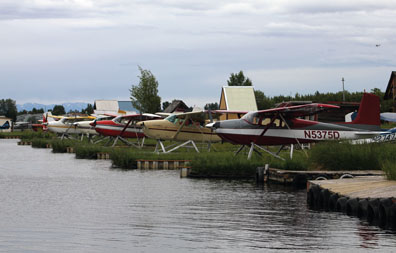NIOSH Partners with Organizations and Industry to Reduce Aviation Fatalities in Alaska
March 2013
DHHS (NIOSH) Publication Number 2013-137

Floatplanes in their slips at Lake Hood, Anchorage, Alaska. Photo courtesy of NIOSH.
A Story of Impact:
During the 1990s, Alaskan workers faced an occupational fatality rate over three times the national average.1 Aircraft crashes were the second leading cause of occupational deaths in Alaska during this period.2 Commercial pilots in Alaska had an occupational fatality rate of 410 deaths per 100,000 workers — five times greater than the rate for all U.S. pilots and nearly 100 times greater than the rate for all U.S. workers.3 In 2000, the U.S. Congress funded the Alaska Interagency Aviation Safety Initiative (AIASI) with the goal of decreasing occupational aircraft crash fatalities in Alaska in half by 2010.
The AIASI was a multifaceted public health approach that focused on air taxi and commuter operations and preventing crashes that were the result of controlled flight into terrain (CFIT). CFIT is the act of flying an airworthy, pilot-controlled aircraft into mountains, water or other terrain. Research had identified CFIT as a frequent cause of aviation-related fatalities, especially in situations in which a pilot departed in good visibility conditions but continued into areas of reduced visibility or poor weather.
Relevant Information
- The number of fatal crashes during air taxi and commuter operations in Alaska decreased 53% between 2000–2009 and the prior decade, meeting the goals set by Congress for the Alaska Interagency Aviation Safety Initiative4
- The rate of fatal crashes per million air taxi and commuter flights in Alaska remains three times higher than in the rest of the U.S.4
- The pilot fatality rate for commercial pilots in Alaska is almost twice the rate for commercial pilots in the U.S.5
Impact
The AIASI consisted of several components that were supported by federal agencies and industry. National Institute for Occupational Safety and Health (NIOSH) research guided the initiative, identifying risk factors and focus areas, conducting a statewide survey of air taxi and commuter operators and pilots, and evaluating the success of safety interventions and regulatory changes. The National Transportation Safety Board was responsible for crash investigations and providing probable cause. The AIASI also launched programs to educate and promote safety among businesses, pilots, and their customers, including the Federal Aviation Administration’s (FAA) Circle of Safety and the Medallion Foundation which was developed by the Alaska Air Carriers Association to improve the safety culture in the aviation industry. The FAA and the National Weather Service worked together to install more than 100 weather cameras across the state and launched a program to provide real-time weather information to pilots via radio. The FAA equipped hundreds of aircraft with Capstone navigational equipment. These interventions and accompanying technology are applicable beyond Alaska: the FAA’s NextGen air transportation system is based on technology that was tested in Alaska as part of the AIASI’s Capstone Program.6The efforts of the AIASI resulted in reductions in numbers and rates of crashes and fatalities in Alaska air taxi and commuter operations. Although all nonmilitary aviation operations showed a significant rate decrease, the greatest improvements were seen in fatal air taxi and commuter crashes. There was also a marked decline in CFIT crashes between 2000-2009 compared to the prior decade.4
While hazards have been reduced, collaborative efforts are still needed to continue to improve the safety of occupational pilots and passengers in Alaska. During the survey conducted as part of the AIASI, NIOSH found that air taxi and commuter operators in Alaska with high crash rates had pilots who worked on average ten hours more per week than those working for operators without high crash rates.7 NIOSH researchers continue to conduct surveillance, work with government agencies and industry to develop and evaluate interventions, and identify new areas of focus for prevention efforts. Current work includes development of training tools to prevent pilot fatigue.
View/Download Entire Document: NIOSH Partners with Organizations and Industry to Reduce Aviation Fatalities in Alaska
![]()
![]()

![]()
Visit the NIOSH Web site (www.cdc.gov/niosh) for more information about aviation safety in Alaska. The study, A Multifaceted Public Health Approach to Statewide Aviation Safety, was authored by Nicolle A. Mode, Mary B. O’Connor, George A. Conway, and Ryan D. Hill, and was published in the American Journal of Industrial Medicine 55:176-186 (2012).
References
1 Alaska Department of Health and Social Services. 2010. Section 10. Occupational Safety & Health. Healthy Alaskans 2010, Volume 1: Targets for improved health Juneau, AK: State of Alaska.
2 Conway GA, Lincoln JM, Hudson DS, Bensyl DM, Husberg BJ, Manwaring JC. 2002. Surveillance and Prevention of Occupational Injuries in Alaska: A Decade of Progress, 1990-1999. Cincinnati, OH: Department of Health and Human Services, Centers for Disease Control and Prevention. National Institute for Occupational Safety and Health.
3 Bensyl DM, Moran K, Conway GA. 2001. Factors associated with pilot fatality in work-related aircraft crashes, Alaska 1990-1999. Am J Epidemiol 154:1037-1042.
4 Mode NA, O’Connor MB, Conway GA, Hill RD. 2012. A multifaceted public health approach to statewide aviation safety. Am J of Ind Med 55:176-186.
5 Centers for Disease Control and Prevention, National Institute for Occupational Safety and Health. Commercial Aviation in Alaska. https://www.cdc.gov/niosh/topics/aviation/ Accessed on 24 July 2012.
6 Federal Aviation Administration. 2007. Fact Sheet – Next generation Air Transportation System 2006 Progress Report. October 10, 2007. http://www.faa.gov/news/fact_sheets/news_story.cfm?newsId=8336
7 Conway GA, Mode NA, Berman MD, Martin S, Hill A. 2005. Flight safety in Alaska: Comparing attitudes and practices of high- and low-risk air carriers. Aviat Space Environ Med 76:52-57.
SAFER • HEALTHIER • PEOPLE™
